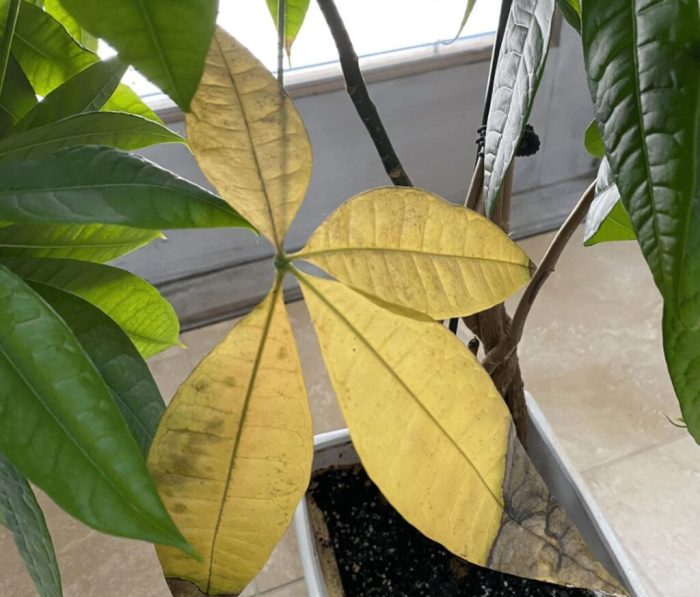Diagnosing the Problem

How to revive money tree plant – A wilting money tree, a seemingly innocuous event, can signal a deeper malaise within the plant’s physiological system. Ignoring these early warning signs can lead to irreversible damage, ultimately resulting in the plant’s demise. Accurate diagnosis is paramount to effective treatment, demanding a careful examination of various contributing factors. This requires a discerning eye and a methodical approach to pinpoint the root cause of the distress.The most common culprits behind a struggling money tree are related to watering practices, light exposure, and the insidious presence of pests or diseases.
Misinterpreting the symptoms can lead to counterproductive measures, exacerbating the existing problems. A systematic approach, focusing on visual cues and a logical elimination process, is crucial for a successful intervention.
Underwatering versus Overwatering Symptoms
The symptoms of underwatering and overwatering, while both manifesting as wilting, present distinct visual characteristics. Underwatering typically results in a dramatic, rapid wilt, with leaves becoming dry and brittle, often curling inwards. The soil will be completely dry to the touch. Conversely, overwatering manifests more gradually, with leaves exhibiting a yellowing or browning discoloration before wilting. The soil remains persistently soggy and may even exhibit a foul odor indicative of root rot.
The key differentiator lies in the soil’s moisture level and the overall texture of the leaves. A carefully considered assessment of these features will guide the appropriate remedial action.
Common Money Tree Pests and Diseases
Money trees, like other plants, are vulnerable to a range of pests and diseases. These infestations can severely compromise the plant’s health and lead to irreversible damage if left untreated.Scale insects, for example, are tiny, immobile pests that attach themselves to the stems and leaves, sucking sap and causing stunted growth. Their presence is indicated by small, raised bumps on the plant’s surface, often accompanied by a sticky honeydew secretion.
Mealybugs, on the other hand, are soft-bodied insects that appear as cottony masses in leaf axils or along stems. They also feed on plant sap, weakening the plant and potentially leading to fungal growth due to the honeydew they excrete. Root rot, a common fungal disease, is often a consequence of overwatering. It manifests as mushy, dark-colored roots and a general decline in the plant’s health, often accompanied by a foul odor emanating from the soil.
Brother, to revive your money tree, remember the earth’s cycles—just as we must nurture our faith, so too must we nurture our plants. Consider the timing, much like deciding when to plant new life, for instance, knowing when to plant fruit trees in Michigan is crucial for a bountiful harvest. Similarly, proper watering and sunlight are key to your money tree’s resurrection; patience, like faith, will bear fruit.
Early detection and appropriate treatment are crucial to mitigate the damage.
Troubleshooting Flowchart
The following flowchart provides a systematic approach to diagnosing the problem based on observed symptoms:
Start -> Is the soil dry? -> Yes: Underwatered; Water thoroughly. -> No: Is the soil soggy? -> Yes: Overwatered; Reduce watering, check for root rot. -> No: Are there visible pests or diseases? -> Yes: Identify pest/disease and treat accordingly. -> No: Check light exposure and adjust accordingly. -> End
This flowchart serves as a preliminary guide. Complex situations may require further investigation and professional horticultural advice.
Reviving Techniques

The resuscitation of a neglected money tree requires a multifaceted approach, addressing soil conditions, structural integrity, and potential infestations. Failure to implement these techniques comprehensively will likely result in further decline, highlighting the critical need for decisive and informed action. This section details the necessary steps to revitalize your ailing plant.Repotting a Money Tree for Optimal GrowthImproper drainage and inadequate soil composition are frequently cited culprits in money tree decline.
Repotting offers a powerful opportunity to rectify these issues, providing a foundation for renewed vigor.
Repotting Procedure
The process begins with selecting a pot slightly larger than the existing one, ensuring adequate space for root expansion without overwhelming the plant. The new pot should possess drainage holes to prevent waterlogging, a common cause of root rot. A well-draining potting mix, ideally a blend of peat moss, perlite, and bark chips, should be chosen. The plant should be gently removed from its old pot, inspecting the roots for signs of rot or damage.
Any diseased roots should be carefully pruned with sterilized shears. The plant is then placed in the new pot, ensuring the top of the root ball is level with the soil surface. The remaining space is filled with the potting mix, leaving a slight gap at the top for watering. Finally, the plant should be thoroughly watered to settle the soil.
Pruning Techniques for Healthy Growth
Pruning is a crucial aspect of money tree maintenance, removing dead or damaged branches and encouraging bushier growth. Improper pruning can, however, lead to further stress and decline, emphasizing the need for precision and understanding.
Pruning Methodology
Identify dead, diseased, or damaged branches. These are typically brown, brittle, or exhibit signs of decay. Use clean, sharp pruning shears to make clean cuts just above a node (the point where a branch emerges from the stem). Avoid ragged cuts, which can increase the risk of infection. For shaping, selectively prune branches to maintain the desired form, promoting balanced growth.
After pruning, it’s recommended to apply a fungicide to the cut ends to prevent infection.
Pest and Disease Management, How to revive money tree plant
Money trees are susceptible to various pests and diseases, requiring prompt intervention to prevent irreversible damage. Ignoring these issues can lead to significant plant deterioration, underlining the urgency of effective treatment.
Pest and Disease Control Methods
Common pests include spider mites, mealybugs, and scale insects. These can be treated with insecticidal soap, neem oil, or other organic pesticides. For severe infestations, chemical pesticides may be necessary. Fungal diseases, such as root rot, often stem from overwatering. Treatment involves improving drainage, removing affected roots, and applying a fungicide.
Bacterial diseases are generally more difficult to treat and may require removing the affected plant parts or even discarding the plant entirely. Regular inspection is crucial for early detection and timely intervention.
Adjusting Watering and Light Exposure
The health of a money tree is intrinsically linked to its watering regimen and light exposure. Inadequate light or improper watering can lead to significant stress and decline.
Water and Light Management
Allow the soil to dry slightly between waterings, preventing waterlogging. Overwatering is a common mistake, often leading to root rot. During periods of dormancy, reduce watering frequency. Money trees thrive in bright, indirect light. Avoid direct sunlight, which can scorch the leaves.
Rotate the plant regularly to ensure even growth. Observe the plant closely; drooping leaves may indicate underwatering, while yellowing leaves may suggest overwatering or insufficient light.
FAQ Guide: How To Revive Money Tree Plant
Can I use tap water for my money tree?
It’s best to use filtered or distilled water, as tap water can contain minerals that may harm your money tree.
How often should I fertilize my money tree?
Fertilize during the growing season (spring and summer) every 2-4 weeks with a balanced liquid fertilizer diluted to half strength.
Why are the leaves on my money tree turning brown?
Brown leaves can indicate overwatering, underwatering, or exposure to extreme temperatures. Check the soil moisture and adjust watering accordingly.
My money tree is dropping leaves. What should I do?
Leaf drop can be caused by various factors including stress from changes in environment, underwatering, or pests. Investigate the potential causes and address them accordingly.
